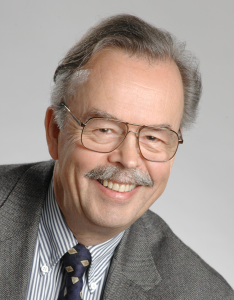Eugene Haller, leading expert in semiconductor materials, dies at 75


by Daisy Hernandez
June 24, 2018
Eugene E. Haller, UC Berkeley professor emeritus in the Department of Materials Science and Engineering and founder of the Electronic Materials Program at Lawrence Berkeley National Laboratory (Berkeley Lab), died on Friday, June 22. He was 75.
Haller, who held the Liao-Cho Innovation Chair at UC Berkeley, was a highly regarded leader in the field of semiconductor materials. Haller’s academic career spanned more than 30 years, and during that time, he emerged as one of the scientific pioneers redefining the field of materials science and engineering to include semiconductors, ultimately co-authoring a textbook on the subject.
Haller’s research contributions were primarily in the area of the growth and applications of ultrapure — both chemically and isotopically — and doped semiconductors.
“Eugene is widely recognized for growing the most pure materials known to humankind,” said Oscar Dubón, professor of materials science and engineering. “His ultrapure germanium crystals formed the basis for the development of highly sensitive radiation and light detectors.”
Indeed, Haller’s ultrapure germanium lies at the heart of one of the important devices in the Spitzer telescope: the Multiband Imaging Photometer for Spitzer detector. This infrared telescope launched into space in 2003 and is still used to study the formation of planets near distant stars. Haller was also known as a consummate teacher and mentor for students and young faculty alike.
“The welfare of his students was always his highest priority — he did all he could to ensure their success,” said Daryl Chrzan, professor and department chair of materials science and engineering.
During his tenure, he directly supervised the research of approximately 50 doctoral students, guided numerous postdoctoral scholars and collaborated with many esteemed visitors. Many early-career researchers whom he mentored have achieved prominent positions within academia, national laboratories and industry.
Haller was born in 1943 in Basel, Switzerland. He earned his diploma in Nuclear Physics in 1967 and his Ph.D. in Solid State and Applied Physics in 1970, both from the University of Basel. In 1970, he joined Berkeley Lab, first as a postdoctoral fellow of the Swiss National Foundation, and then three years later as a staff scientist. In 1980, Haller was appointed associate professor in the Department of Materials Science and Mineral Engineering at UC Berkeley, becoming professor in 1982. Haller would remain on the faculty at UC Berkeley and as faculty senior scientist at Berkeley Lab through 2011.
In 1984, Haller founded the Electronic Materials Program (EMAT) at Berkeley Lab, which continues to this day. Though EMAT was not the first center at the Department of Energy (DOE) to be focused on semiconductors, it was established near the beginning of DOE’s interest in semiconductor materials.
“Haller was one of the key scientists who pushed DOE to expand further into the area of semiconductor research, and his efforts helped to establish semiconductor materials as an important area of research for DOE,” said Chrzan.
Haller was a major figure in the semiconductor defect community. He authored or co-authored well over 1,000 papers during his career. He also provided significant leadership for its most important series of meetings, The International Conferences on Defects in Semiconductors. He hosted and chaired the 20th meeting at UC Berkeley. He also served on the editorial advisory
boards for major journals and on numerous advisory boards and panels throughout his career.
Among the many prestigious awards Haller earned throughout his career are the 1999 James C. McGroddy Prize for New Materials from the American Physical Society, the 2005 David Turnbull Lectureship from the Materials Research Society and the 2010 John Bardeen Award of the Minerals, Metals and Materials Society.
In 2010, Haller was elected into the National Academy of Engineering for “improvements in semiconductor performance through contributions to the synthesis of ultrapure and doped crystals.” Election into the National Academy is among the highest of honors awarded to engineers in the United States.
When Haller was not teaching or performing cutting-edge research, he worked toward expanding his collection of antique radios and growing his extensive cacti garden. He also enjoyed working on his 1939 Talbot-Lago T123 vintage car — one of only twelve remaining vehicles of this model.
Those who knew Haller fondly recall his sharp mind, his unrivaled talent for conducting experiments, his incredible leadership skills, his fierce loyalty and his wry sense of humor. “He will be missed not only for his scientific contributions but also for his deeply caring and thoughtful nature,” said Dubón. “We have lost a teacher, a mentor, a scholar and a friend.”
Haller is survived by his wife, Marianne, his daughters, Isabelle and Nicole, and their families.
Contact Us
Department offices are located in 210 Hearst Memorial Mining Building, in the Northeast corner of campus.
Address:
| Department of Materials Science and Engineering | |
| 210 Hearst Memorial Mining Building University of California Berkeley, CA 94720-1760 |
Phone: (510) 642-3801 Fax: (510) 643-5792 |
